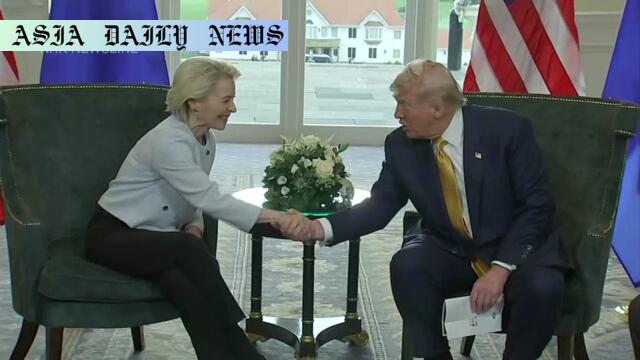Tariff Agreement: President Trump Announces 15% Tariff as US, EU Reach Landmark Trade Deal
US President Donald Trump confirms a tariff agreement with the EU at 15%, lowering it from a proposed 30%.
The deal includes a $750 billion energy purchase commitment by the EU and $600 billion investments in the US.
European countries will operate under a zero-tariff regime, excluding steel and aluminum at 50%.
Trump declares the deal as historic, while EU President von der Leyen emphasizes stability and predictability in the trade relationship.

Introduction to the Historic Tariff Agreement
The United States and the European Union recently announced a landmark trade agreement, hailed by President Donald Trump as a transformative deal between two of the world’s largest economies. The agreement reduces tariffs between the two parties, creating significant economic opportunities and fostering deeper cooperation in trade. This development was revealed after President Trump’s meeting with European Commission President Ursula von der Leyen in Scotland on Sunday.
The Revised Tariff and Its Implications
At the forefront of this agreement is the decision to drop the proposed 30% levy on EU imports to 15%, impacting a wide range of goods, including automobiles. While this adjustment sharpens economic accessibility, the 50% tariff on steel and aluminum remains intact, ensuring selective protection for US industries. This carefully balanced approach aligns with the broader goal of creating a fairer and more competitive trading system with the EU. According to President Trump, the deal stands as “the biggest deal ever made,” showcasing its significance in restructuring global trade relations.
The $750 Billion Energy and Trade Commitment
The agreement also includes an EU commitment to purchase $750 billion worth of energy products from the United States, further strengthening US energy exports. Moreover, the EU has pledged $600 billion in investments within the US economy, fostering job creation and innovation. These large-scale financial commitments underline the intertwined economic futures of the US and EU, signifying a milestone in their relationship.
Zero-Tariff Provisions and Broader Trade Opportunities
Another prominent aspect of the deal is the opening of European markets to US goods under a zero-tariff regime, barring specific exceptions such as steel and aluminum. This provision could lead to an influx of US exports to Europe, benefiting American industries while providing European consumers with more options at competitive prices. President Trump highlighted the significance of this development as a step towards fair and balanced trade practices.
Stability and Predictability in Global Trade
President von der Leyen, from the EU’s perspective, emphasized that this agreement would usher in stability and predictability in global trade dynamics. This sentiment resonates well with businesses on both sides of the Atlantic, which value consistency and longevity in trade policies. The deal exemplifies diplomatic cooperation, enhancing mutual trust.
The Global Ramifications
The US-EU trade agreement has far-reaching implications beyond the two entities involved. It sets a precedent for international trade deals, particularly in a time where protectionist policies have dominated the narrative. By working out a mutually beneficial arrangement, this deal proves that economic partnerships are still achievable even amidst global uncertainties.
Conclusion
In conclusion, this agreement between the United States and the European Union redefines their economic engagements. The reduction of tariffs, large-scale energy agreements, and mutual investments represent a forward-looking vision for bilateral trade. This historic moment marks a significant step in global trade, fostering stability, innovation, and growth in the years to come.



Commentary
Analysis of the Tariff Agreement
The recently announced tariff agreement between the United States and the European Union has sparked intrigue and optimism across global markets. By setting the new tariff rate on goods at 15% instead of the initially planned 30%, a critical threshold has been crossed where both parties demonstrate their willingness to collaborate effectively. This decision caters not only to regulatory needs but also to the expectations of manufacturers and consumers from both economies. Balancing protectionist policies for steel and aluminum with new trade openings creates a nuanced approach to modern economic diplomacy.
A Leap Towards Economic Integration
The inclusion of a $750 billion energy purchase by Europe signifies more than just a boost in US energy revenues. It represents an unprecedented level of trust and interconnectedness between two economies. By committing vast investments into the US, European nations are not only diversifying their economic activities but also creating visible synergies. These actions strongly suggest a re-orientation of EU priorities in terms of trade relationships, especially in the current geopolitical climate.
The Impact on Global Trade Trends
As global economies grapple with rising protectionism, the agreement demonstrates that it is possible to find common ground even among diverging trade philosophies. This deal may signal a potential slowdown in a worldwide trend towards isolationism in trade. Other nations could look at this as a model to emulate or study closely.
A Bright Future or Challenges Ahead?
While the deal brings promise, there are understandable concerns. Will these commitments hold strong amidst political changes? Will industries excluded from the zero-tariff agreement feel the strain? One thing is clear, though – this agreement sets a powerful precedent, proving that economic diplomacy is never off the table. Moving forward, transparent communication and a shared commitment to adherence will determine the success of this historic initiative.